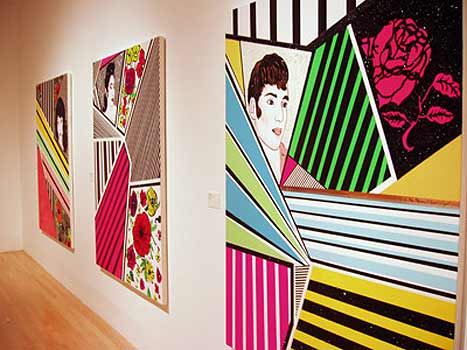Los Angeles County Museum of Art ,
Apr 06, 2008 - Sep 01, 2008
Los Angeles, CA, USA
Phantom Sightings: Art after the Chicano Movement
by Ruben R. Mendoza
Erased Erasing: Representation after the Decontextual Movement
The problem is not that the curators don't "get it," most certainly, they do: It's about fusion, hybridity, mutation, and a particularly charged moment of multivalent transformation. They get it, and they want to participate in the conversation. And of course, they are more than welcome and needed, this critique in no way seeks to articulate an exclusionary, anti-intellectual stance.
But the conversation here is also about institutionalization, and although the curators get this, too, it seems that in some ways, they cannot avoid their institutionalized positions. So with one foot inside, and one (toe) outside, the institution, they attempt to have it both ways. The result is a kind of tension that,
at its worst, teeters over a disidentifying edge into the depoliticized, identificative realm of assimilation. The conversation thus stalls, substituting for the contextualizing, transformative, experiential process that defines the most effective Chicana/o art and cultural production, with an interpolated, decontextualized representation of that transformation.
No Phantom Sightings work demonstrates the negative repercussions of this overly eager ontological leap into the institutionalized "post-" better than Ken Gonzales-Day’s Erased Lynching series (2004-6). In these reproductions of postcards depicting lynchings of Mexicans by Anglos in the U.S. Southwest between 1850 and 1935, Gonzales-Day has digitally removed the victims, leaving the crowds of onlookers, or sometimes, just the tree from which the victim was hanged. One of these photos is blown up and stretched over two facing walls
-one, a matte finish, the other, a reflective finish that mirrors the viewer so that s/he appears among the onlookers.
Clearly, Gonzales-Day is concerned with issues of spectacle, complicity, and the construction/erasure of the other involved in dominant subjectivity formation.
And the impulse behind digitally removing the victims from photographs undoubtedly involved difficult issues surrounding fetishization and the representation of violence. However, we must ask what is ultimately accomplished by this digital erasure, given that dominant U.S. society has been trying to erase the victims, and the crimes, from the historical record all along,
in a process of internal colonization, state and vigilante terrorism, and ethnic cleansing, that continues to fuel a de facto apartheid of educational and economic disenfranchisement, militarization, and incarceration. Like his book, Lynching in The West: 1850-1935 (2006), Gonzales-Day’s photographs here fail to adequately contextualize these lynchings as part of a specifically Chicana/o history of U.S. imperialism and colonization despite the significantly post-U.S./Mexico War timeline of 1850-1935, as well as the discourse of Chicana/o historians surrounding the post-war violence toward, and resistance by, the specifically Mexican/nascent-Chicana/o population within the newly occupied Southwest.
Of course, Lynching in the West is technically not part of this exhibition. But it provides valuable insight, because the book’s insistence on stripping this imperialist history of a Chicana/o context prefigures Erased Lynching’s decontextualization. Coupled with Gonzales-Day’s general decontextualization, then, this formally clever device of digital erasure points to, and serves, a broader depoliticizing stroke.
Reframing the Framing: Building the (Im)perfect Countermuseum
At its best, though, Phantom Sightings’ curatorial tension propels the exhibition through a participatory process of transformative meaning-making/unmaking, not only theorizing a "rupturing space" of transformation, but actually creating it.
Two hybrid, multimedia installation works in particular operate in a dialogical, decolonial imaginary, by turning the energy of that curatorial tension toward itself, directing it point-blank back at the institution that produced it: Sandra de la Loza’s Fort Moore, Living Monument (2008), and Arturo Ernesto Romo’s Rended Façade (2007-8). By creating complex, immersive, multi-media environments that function as mini-/meta-/counter- museums within the larger institutional structure, these pieces reframe the framing, subverting it by inverting it from within and creating a kind of portal through and beyond its structures out into the streets, parking lots, and other borderlands, where these works originated.
In Sandra de la Loza’s Fort Moore, Living Monument, the interventionist urban-space tactics of her Pocho Research Society are brought simultaneously into and beyond the museum space as de la Loza uses the museum against itself through a mutative insertion of hybrid urban and faux-museum space that simultaneously makes and unmakes meaning and myth. An immersive, meta-mini-museum of both real and hoax materials about Chicanas/os and other indigenous populations in the context of Los Angeles "history," the installation includes digital video of a self-deconstructing monument originally erected at the site of Fort Moore
(in memory of a "victory" of the U.S. in its war with Mexico). In one blow-up of an early twentieth century newspaper page, the headline about an underground "Lost Lizard City" of native-Indian legend shouts, DID STRANGE PEOPLE LIVE UNDER SITE OF LOS ANGELES 5000 YEARS AGO? On the same wall, an authentic-looking map-painting on rock fragment depicting "Nuestra Seçora de Los Angeles" and indigenous communities is identified as likely having been completed sometime around the first colonization of the area by Spaniardsçdespite subtle, curiously anachronistic symbology and iconography of contemporary Chicana/o culture. Which document is real? Are any "real"? How are documents and artifacts used to produce history, subjectivity, identity, space specifically within the institutionalizing parameters of the museum and academy? And in a culturally specific sense, how has this manipulation shaped Chicana/o culture and identity in the context of Spanish and U.S. imperialism? In raising these questions in the way that she does here, de la Loza not only calls into question the space of the museum and its role in these processes (and our complicity and/or resistance), but actually transforms it and therefore one’s experience of it thus destabilizing the ideologies of the institutional that undergird both.
|









